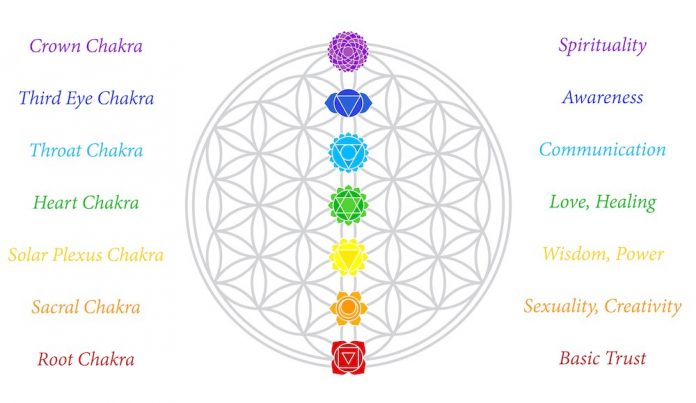
We’re all interested in restoring and maintaining our energy levels, right? But have you thought about it in relation to your chakras? Yes, chakras are the energy centers in your body, and although they are spiritual in nature and we can’t see them, that doesn’t mean they don’t have a significant impact on our lives.
What are chakras?
The chakra system was developed in India between 1500 and 500 BC. The word “chakra” is Sanskrit for “wheel” or “disk” and refers to seven areas along the spine and the crown of your head. Each chakra harbors “prana,” which is said to be the ultimate healing energy.
Each chakra corresponds to specific organs as well as physical, emotional, psychological, and spiritual states of being. In addition, it is believed that when these energy centers are open and in line or balance, the body’s energy or prana can flow freely throughout the body.
Your chakras need energy in the form of certain foods, in moderate amounts, to sustain themselves and help keep your energy flowing freely. First, you need to understand the purpose of each chakra and how blockage can make you feel. Then you can nourish your chakras with certain foods and herbs that can support them and achieve better balance and healing in your life.
Read about Eastern spiritual practices
Foods and herbs to balance your chakras
Root chakra (muladhara)
The root chakra is represented by the color red and is located at the base of the spine. Its location suggests its purpose: to keep your body’s energy grounded or connected with the energies of the Earth. Muladhara helps with self-esteem, survival, and movement. The root chakra may be blocked if you feel threatened or anxious about basic needs, such as food and money.
Support your root chakra with root vegetables (e.g., beets, carrots, garlic, onions, radishes, potatoes) and food rich in protein (e.g., beans, soy, peanut butter, tofu). Ashwagandha, cloves, paprika, pepper, and rosemary are herbs and spices associated with the root chakra.
Sacral chakra (swadhistana)
The navel is the location of this chakra, which is represented by the color orange. Swadhistana is associated with creativity and emotions and helps with balance and control in your life when it is healthy. This chakra may be blocked if you are having relationship problems or doubt your creative abilities.
Feed your sacral chakra with naturally sweet foods such as coconut, honey, mangos, melons, oranges, and strawberries. Other sources of nourishment include beans, seeds, nuts, cinnamon, coriander, licorice, sesame seeds, turmeric, and vanilla.
Solar plexus chakra (manipura)
Yellow is the color of the solar plexus chakra, which is involved with self-esteem and ego. Your intuition and ego are in balance when this chakra is open.
The solar plexus is nourished with grains, seeds, and dairy products such as yogurt and cheese. Healing herbs and spices include anise, chamomile, cinnamon, cumin, fennel, ginger, and turmeric.
Read about heart chakra meditation
Heart chakra (anahata)
This is your heart center and is represented by pink and green. It is also sometimes called the personal power chakra. Blockage of the heart chakra may appear as feelings of insecurity or not being good enough, or as digestion or memory problems.
The heart chakra benefits from leafy green vegetables as well as broccoli, cauliflower, celery, and raw foods. Basil, cilantro, hibiscus, jasmine, moringa, rose, sage, and thyme are beneficial as well as green teas.
Throat chakra (vishuddha)
This sky blue chakra represents responsibility, will power, and the ability to express oneself. When the chakra is blocked, it may manifest as an inability to say what you want to say or you can’t find the right words.
You can help keep your throat chakra healthy by providing it with water, juices, and herbal teas. Lemongrass, peppermint, sage, sea plants, soups, and tart or tangy fruits are also helpful.
The third eye (Ajna)
The center of the heat or brow is the location of the third eye, whose color is indigo. When your third eye is in balance and working optimally, you have an ability to see the big picture and your intuition is sharp. When blocked, you may struggle with your purpose in life or find it difficult to make decisions.
Nourish your third eye with dark fruits such as blueberries, raspberries, blackberries, and grapes, along which chocolate. Eyebright, poppy seeds, rosemary, and tulsi (holy basil) also help support this chakra.
Crown chakra (Sahasrara)
The highest chakra is the crown chakra, which is located at the top of the head and designated as white or violet. A balanced crown chakra is essential for creating the life you love and feeling peaceful. Trauma can block this chakra and cause you to feel depression and a loss of spirituality.
The healthiest herbs and spices for the crown chakra are copal, frankincense, garlic, gotu kola, juniper, lavender, lotus, myrrh, and sage. You can best develop this chakra by practicing fasting and detoxification because they can help stimulate spiritual communication.
Bottom line
Choosing the right foods, herbs, and spices is one way you can help restore balance to each of your seven chakras. Other methods include meditation, chakra yoga, Reiki, and emotional freedom technique. For beginners, however, changing your diet and incorporating moderate amounts of the various foods associated with each chakra is a good start to rebalancing these energy channels.
Learn more about:
The Health Benefits of Moringa
Sources
Gaia staff. Balance your chakras with food. Gaia 2013 Apr 13
Hurst K. 7 chakras: What is a chakra? How to balance chakras for beginners. Law of Attraction.com
Zoldan RJ. Your 7 chakras, explained—plus how to tell if they’re blocked. Well + Good 2018 Aug 2










